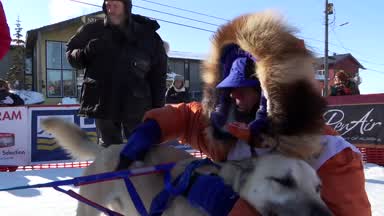
The Red Lantern has always been, for me, an award that is a matter of perspective. However, more recently it has become a great teaching tool. Through my years of teaching about the Iditarod, students have always asked why there is an award for the last place finisher. This prompts many discussions and stories of “participation trophies” in soccer or other sports. This then leads to the questions of “Why doesn’t everyone get an award?”, “Why not the last 3 finishers get the prize?”, or “Why does the loser get a trophy?”. All valid questions, but again, only from one perspective. As teachers, we try to expand the thoughts of our students and get them to see things from more than one vantage point. This is a perfect instance in which to accomplish that task.
From here, I lead my class in thinking more deeply about WHY the last place finisher DESERVES an award. This usually takes a minute to sink in with everyone. But once they begin to think about it with this mindset, it leads to the perspective that I drive home with my students every year; it’s not about winning or losing, but about doing your best to accomplish your goals.
This is a perfect segue to begin discussing these same things within our own classroom. Therefore, the Red Lantern becomes more of a teaching tool. We begin to talk about important terms like grit, determination, persistence and perseverance. Not just for the mushers in the race, but for each of us in the classroom.

This is an activity that I usually integrate during the race itself (which coincides perfectly with “Spring Fever” when students sometimes start to coast a bit, leading into Spring Break). I tell the class that every day during the race, I will choose a new “Red Lantern Winner” from all of the students in the class. Just like the mushers, I choose the student that best exemplifies the aforementioned qualities with their WORK. We do a little ceremony at the end of the day where I announce the day’s winner and tell the class why I chose that individual. They all cheer for each other, and the following day, that student keeps the lantern on their desk. At the end of the week, we take a group picture of the winners in front of the Iditarod race map or question board in the hallway and post it on our class twitter page.
It ends up being a GREAT motivational tool and something fairly simple to maintain that intrinsic motivation, during a normally difficult time. This is something that could be used at any point in the year, and with the holidays coming up, might also be used now.
Therefore, the Red Lantern goes from being a symbol of “coming in last” to a token of perseverance to the person who, even though they knew they would come in last, decided to continue on and accomplish their goals. Again, it’s all a matter of perspective.
Click here for the full lesson plan: Red Lantern Award Lesson Plan
Check out these Insider videos of some of the past Red Lantern winners!


Connecting with Classrooms:
Jill, a STEM teacher from Maryland, shared this great crime scene lesson with me called “Who Kidnapped the Sled Dog”. In this lesson, students take on the roles, and use the tools of a forensic science team to try to figure out who took the sled dog. Using the powers of observation, the students investigate shoe prints left on the floor, examine hair, fibers and fingerprints left at the scene. She gets other teachers in the building to play the “suspects” and has her students question them after the evidence has been collected. They even collect the evidence in “evidence bags”! Thank you for the great lesson idea Jill!
If you are interested in having your classroom/ Iditarod lesson featured in a future issue of “Classroom Connections”, please reach out to me! I am available at emailtheteacher@iditarod.com.












